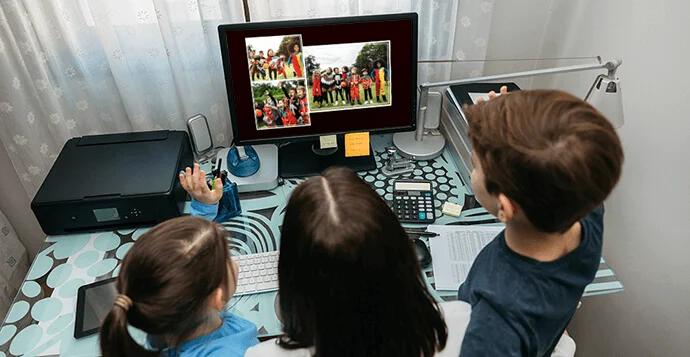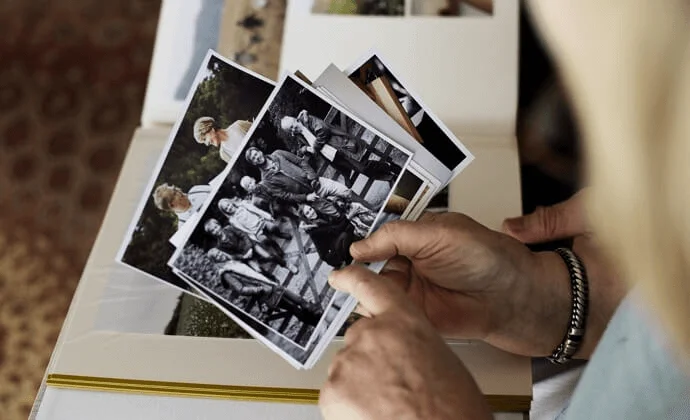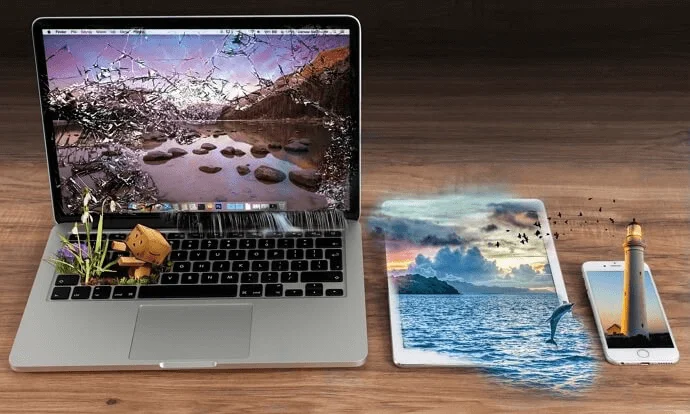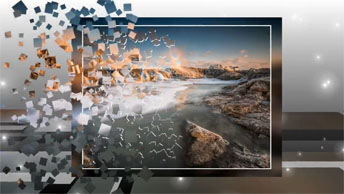How to Make a Good Photo Slideshow
Create an Awesome Slideshow All by Yourself
Do you have a pile of disorganized pictures and want to make a good slideshow, but have no idea what to begin with? In fact, it’s pretty straightforward once you know the ropes. The trick is turning that stack of photos into a story — a visual one that grabs attention and sticks with people.

But you might be asking, “What’s the magic formula for a great photo video?” Well, here’s the thing — there isn't a one-size-fits-all answer. But there are a few key ingredients you can’t ignore. The right photos, the perfect pace, the soundtrack (music, yes please!), and those transitions — oh, the transitions — make all the difference. And that’s just the start. Stick with me, and I’ll share how you can easily nail those details.
7 Essential Tips for Making the Best Slideshow with Pictures
Making a slideshow is about weaving photos and videos into a story, capturing emotions, and squeezing every bit of impact out of the photos you’ve taken. Whether you're putting together memories from a family trip, prepping a presentation for work (yawn, but it’s important!), or just showcasing your best moments, a great slideshow can do all the heavy lifting for you. You want your slideshow to fulfill its purpose (whatever it might be), don’t you? So, here you can learn how to make sure your slideshow is much more than just “okay.”
1. Start with a Strong Theme or Storyline
Every good slideshow needs a solid foundation. Without a theme or a storyline, it’s just a bunch of pictures. Once you know what you are preparing it for, everything else falls into place. Your slideshow will definitely feel more convincing if you start with a clear message.
2. Pick the Right Photos
It can be tempting to throw in every single photo you want, but less is often more. Aim for a curated collection. Сarefully select images that tell a story and support your theme. We do suggest you choose high-quality photos that fit together, and leave out the rest.

3. Get the Timing Right
Timing is everything! (And no, it’s not about being late to a party.) The speed of each slide matters. If it’s too fast, your audience won’t have time to appreciate each photo. Too slow, and it’ll feel like an eternity. Make sure the pacing fits the mood of your slideshow. A quick, energetic slideshow is great for action shots. On the other hand, a slow, thoughtful pace is perfect for more reflective works (like a memorial slideshow).

4. Use Transitions to Enhance, Not Distract
Transitions can be fun, but remember — it is simplicity that leads to elegance. A flashy transition every five seconds can quickly turn your slideshow into an eyesore. Picking transition effects that fit the mood of your work is a much cleverer approach. A soft fade is fine for something romantic; a quick wipe or slide perfectly fits travel or adventure-themed slideshows.
Whatever holds true for high art doesn’t necessarily apply to a slideshow. So our suggestion is: gently enhance your story, don’t try to overwhelm your audience with it. After all, it is just a business presentation or a video greeting card — not an Oscar-winning movie.
5. Choose Music That Matches the Vibe
Music is where the magic happens. A carefully chosen track can set the right mood for your slideshow. Think of it like this: a gentle piano piece is a clever choice for a wedding slideshow, while an upbeat rock anthem naturally fits a travel slideshow. Make sure the music is royalty-free, though. Otherwise, you might deal with some very unfun legal issues.
6. Add Captions, but Keep Them Simple
Sometimes, a picture really does need a thousand words — but not always. A few short phrases can add context, humor, or introduce a theme. But — and this is important — don’t overdo it. Keep it minimal, and do not experiment with the fonts too much either. You don’t want your text to drown out the photo itself, do you? Simple, clean, and easy to read — that’s the key.
Make sure to incorporate clips into your slideshow as well. First of all, they add more dynamics to your video. Besides, the stories they tell are a lot more visual and interesting than just still life photos. But do not overdo on the number of clips - try to keep it down to three per slideshow.
7. End with Something Lasting
The final slide is just as important as the first, so don’t let your slideshow fizzle out at the end! Leave your audience with a lasting impression — it can be a thank-you note, a final group photo, or, say, a call to action if it’s for work. Whatever you choose, make sure the last slide feels just as impactful as the opening one.

Bonus Tip: Feel Free to Experiment
Sometimes, the best results come when you throw any instruction or guide (including of course ours) out the window. Don’t be afraid to experiment. Try different layouts, effects, and music tracks — and you might be able to create something memorable and impressive. Don’t feel compelled to do it just because everyone else around you does the same, though. In other words, don’t overdo it. For some occasions, minimalism is still the best style.
Choose the Right App
for Making a Slideshow from Pictures

Here is another question that often gets overlooked: what app should you choose? Tools matter — and this banality holds fully true for crafting a photo slideshow. We won’t go into the names of the brands at the moment. Let’s simply say that you’ll need to choose between an offline program and an online tool, being the two major solutions. Both have their perks, so let’s break it down.
Offline Slideshow Software
Offline slideshow creators are installed directly on your computer, meaning you don’t need an internet connection to use them. These editing tools often come with “a lot more power under the hood” (to remember Jeremy Clarkson) and make you enjoy complete control over your project. Here's why you might want to go with an offline tool:
- No internet required: Once you’ve installed the software, you can work on your slideshow without needing Wi-Fi, which is especially useful when you're in a place without internet.
- Better control and customization: If you’re a bit of a perfectionist, offline tools normally give you more flexibility with transitions, animations, and effects. You can tweak nearly every detail. Needless to say, this is especially important for professional use.
- Handles large files better: If you’re working with high-resolution images or video clips, offline tools are definitely much more efficient in dealing with those hefty files.
- Your data won’t be leaked: With desktop software, you can rest assured that your personal information won’ t be shared with third parties.
Any fine print? Offline “slide makers” tend to be quite pricey, and you also might have to invest some time learning how to use them. The operating system matters too — Windows-based software most likely won’t run on your Mac. But if you’re looking for full control and are willing to put in the effort, offline programs are clearly the way to go.
Online Slideshow Makers
In contrast, web-based video slideshow makers allow you to create your slideshow online — that is, directly in your browser. These are excellent for quick and easy projects; they also are much simpler to use (as a rule, but not always so). Here’s why you might consider an online service:
- No installation needed: You don’t have to download anything. Just hop onto your browser and start creating. It is not that “difficult, difficult, lemon difficult,” to remember Dustin Hoffman in Wag the Dog (and not nearly as disgusting as his character in this film).
- Access from anywhere: Because it’s all online, you can access your slideshow using any device — your laptop, tablet, or phone — just as long as you’ve got an internet connection.
- Collaborate with others: Some (but by no means all!) online tools let you collaborate with other people, which can be great if you’re working on a group project or want to share the work with family and friends.
However, online tools almost always are a bit lighter on features (this applies to all online services, including video editors and such). You won’t get as much customization, and the performance might not be as smooth when dealing with large files. Plus, you’ll need a good internet connection to keep everything working properly.
Offline vs Online: A Quick Comparison
To make things easier, here’s a simple table comparing the features of offline vs. online tools:
| Feature | Offline Slideshow Software | Online Slideshow Maker |
|---|---|---|
| Free/Trial Version Available | ||
| Advanced Features | ||
| Works Offline | ||
| Customization Options | ||
| Ease of Use | ||
| Access from Any Device | ||
| Professional Use Capability | ||
| Protection of your data |
Now, compare your needs with what each solution offers (as shown in the table), and make your choice! (We’d still opt for a desktop program, though — it allows for more professional results.)
How to Create a Slideshow of Pictures with SmartSHOW 3D
We are afraid to sound overenthusiastic, but with SmartSHOW 3D, making a slideshow video is a walk in the park. Seriously, it’s easy, quick, and pretty fun. Regardless of whether you’re just starting out or you’ve been making slideshows for years, we think you should give this tool a try. So, here's how you can whip up a slideshow with it:
- Install SmartSHOW 3D – First, download and install the program. It’s impressively easy-to-use, and it’ll be ready to go in a couple of minutes.
- Launch the Program – You’ll be prompted to start a new project from scratch or to pick a slideshow template. Opt for a template if you don’t want to invest your time and energy into something that needs to be done ASAP (like those business presentations we always remember about at the last minute).
- Add Your Photos – Use the file tree to bring in the pictures you want to include. You can drag them in directly, which makes things even easier.
- Arrange Your Slides – Once your photos are in, simply drag and drop them around to order them however you like. You’ve got total control over the timeline here. Feel free to manually set the duration for each slide if the default duration is not what you want.
- Customize Your Slides – Here is where you can get creative! (But don’t feel like it’s a must: a minimalist-style presentation often works fine for business purposes — but we believe we’ve already said that.) You can change up the animations; add background music, transitions, or text. Personalize it as much as you want.
- Save and Export – View your slideshow beforehand. When you’re happy with how it looks, export what you’ve done in the format you prefer (MP4, AVI, you name it).
It’s that easy! Here is your beautiful slideshow, created in just minutes. (All right, half an hour it is in most cases.) If you get stuck at any point, follow the link to view a step-by-step video tutorial that will help you along the way.





Make a Photo Slideshow for Different Purposes
A slideshow with pictures is useful on many occasions. It is a way to tell a story, share experiences, or promote your work — in short, it can be made to fit any event. Here are a few examples where a well-crafted slideshow can show its best:
Travel Slideshow
A travel slideshow is there to relive your adventures and share them with friends and family. When crafting one, you can add quick text comments on the places you visited, choose a soundtrack that complements the mood, and include a map to guide the audience through your travels. A great option to tell a story of your journey in 5 to 10 minutes.
Memorial Slideshow
A memorial slideshow is a way to honor someone’s life and legacy. It usually finds its proper role in a funeral, memorial service, or personal tribute. This type of slideshow brings together some touching memories about what the deceased one used to do or say with meaningful music. Creating one, we can celebrate the life of those who are no longer with us, paying a lasting tribute through images and sound.
The key thing is to never try to create a memorial slideshow “at any cost” — sometimes, it just feels inappropriate. We should be guided by our sense of tact when deciding whether we really want to go ahead with one.
Slideshow for Family or Special Occasions
A slideshow can be an opportunity to celebrate life’s big moments — say, a wedding, a family reunion, or someone’s 50th birthday. Pick the photos that capture the spirit of the event, and pair them with music that matches the vibe. Your loved ones will appreciate your efforts, we promise.

Making a Photo Slideshow for Your Business
For meetings with customers, marketing campaigns, or product launches, a professional slideshow presentation can help you communicate your message with style. With it, you can showcase your brand, or demonstrate a product, or perhaps try to “sell your skills” in a job interview. A well-designed business slideshow grabs attention and leaves an impact.
Keep things clean and straightforward with elegant transitions that highlight your content without stealing the spotlight. Avoid anything that looks adolescent or immature.
Educational Slideshow
If you’re teaching or giving a lecture, an educational slideshow can simplify complex topics and make information easier to understand. Organize your images and text clearly, and use transitions to maintain the flow of the presentation. When done right, an educational slideshow engages your audience, ensuring they stay focused and remember what you’ve taught them. Don’t see it as a “magic artifact,” though: what you teach comes first. How you do it is of secondary importance.
Creating a Slideshow from Pictures for Social Media

Social media take up a big part of our daily lives. A video slideshow would capture attention and share your memories or creative work with your followers. However, each platform has its specificity — which is why you’d better be aware of how to make your slideshow fit its format. So, would you like to promote yourself or your product on social media? Here’s how you can do it:
Know the Format Requirements
Each social media platform has its own format preferences. Instagram and TikTok, for example, thrive on vertical videos. YouTube and Facebook are better suited for horizontal ones. Before you go ahead with crafting a slideshow, find out a thing or two about the platform’s preferable aspect ratio and size guidelines. Good news: most slideshow makers, including SmartSHOW 3D, offer presets that automatically optimize your slideshow for social media.
Keep It Snappy and Engaging
On social media, capturing attention quickly is crucial. Delivering punchy, engaging content hooks your audience instantly. So, aim for a concise, engaging slideshow. For platforms like Instagram or TikTok, we suggest that you make your slideshow not longer than 60 seconds, preferably closer to 30. Keep the pacing quick and energetic with a focus on your most striking images. Fast transitions and lively music will help keep the momentum high and your viewers hooked.
Add Captions and Hashtags
Captions are your chance to add context, personality, and some flair to your slideshow. Sometimes, the right caption makes all the difference — as a witty comment that clearly contradicts what the viewer sees on the screen.
Hashtags are equally important. They help increase the visibility of your content and make it easier for users to discover your slideshow. Think about trending hashtags like #Wanderlust or #MemoryLane to help your slideshow get noticed by a larger audience. (Yes, we know those ones sound somewhat cliché. But this is the very nature of hashtags.)
Share Your Slideshow and Promote It
When your slideshow is ready, it’s time to share it with the world. You cannot just upload and forget about it (unless you are Elon Musk, that is). The idea is to cross-promote it on all your social channels to maximize its reach. Tag relevant people, places, or brands to help spark engagement. The more of your time and energy you invest into it, the more likely your slideshow is to be seen and appreciated by a broader audience.
Conclusion
Here, finally, are some takeaways. Creating any type of a slideshow — be it for a personal project, business, or educational needs — requires attention to the details. Start with a clear theme or storyline, select only the best photos, and be mindful of timing and transitions. Music, captions, and a strong ending will elevate the impact of your slideshow. While offline tools offer greater control and customization, online slideshow makers can be convenient for simpler projects.
We’ve shared with you all we know about making video slideshows to help you create stunning and eye-catching products. So now that you know how to make a good slideshow, go ahead and share your beautiful pictures with the whole world!
Frequently Asked Questions
What is the easiest way to make a photo slideshow?
The simplest manner to create a slideshow with images is to use a straightforward slideshow maker like SmartSHOW 3D. With its intuitive drag-and-drop interface and pre-designed templates, you may prepare a stunning slideshow in just a few minutes. No technical capabilities are required.
What is the best program to use to create a picture slideshow?
This depends on what you’re after. For those who are just starting, SmartSHOW 3D is an exceptional choice, presenting a user-friendly interface without sacrificing quality. For greater customization, you could decide on tools like PowerPoint or Canva, which offer greater flexibility for more advanced users. Additionally, there are several mobile apps that let you create a simple slideshow on your phone.
Is SmartSHOW 3D a free slideshow app?
SmartSHOW 3D isn’t free, however, it does have a free version that allows you to use its basic features. If you’re looking for a truly free option, there are other free slideshow makers online that you might want to explore, although their functions could be limited, when compared to those of SmartSHOW 3D.
What are the different slideshow formats?
There are some formats you may select from, such as MP4 video, PDF (for non-interactive slideshows), and image sequences like JPEG, PNG, or GIF. For sharing on social media or via email, MP4 is usually the most famous and widely supported format.
How to create a slideshow for my phone?
To make a slideshow for your mobile device, you may use Google Slides (accessible from your Google Drive) or Canva. These apps are designed to let you create slideshows on the go, making it easy to share your work regardless of where you are. Remember, though, that the capability of mobile apps is limited and they don’t allow for precise adjustments.
Get started with SmartSHOW 3D to create a masterpiece!




